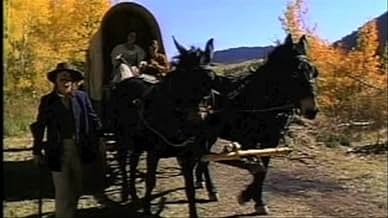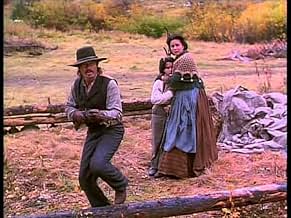In the 1850s, a boy and his family are stranded in the Rocky Mountains. With the help of a local mountaineer, a Sioux medicine man, and a legendary bear known as "Walking Thunder, " the boy ... Read allIn the 1850s, a boy and his family are stranded in the Rocky Mountains. With the help of a local mountaineer, a Sioux medicine man, and a legendary bear known as "Walking Thunder, " the boy learns to become a man.In the 1850s, a boy and his family are stranded in the Rocky Mountains. With the help of a local mountaineer, a Sioux medicine man, and a legendary bear known as "Walking Thunder, " the boy learns to become a man.
- Awards
- 1 nomination total
Irene Miracle
- Emma McKay
- (as Klara Irene Miracle)
Ted Thin Elk
- Dark Wind
- (as Chief Ted Thin Elk)
K.C. Clyde
- Danny McKay
- (as a different name)
Dane Stevens
- Angus Campbell
- (as Duane Stephens)
Brian Keith
- Narrator
- (voice)
Featured reviews
This movie was shown on the Discovery-Animal Planet network.
The bear, if there ever really was a bear, is the second supporting character. A delight and disconcerting at the same time. There is a native-american belief that animals could take on human bodies and vise-versa. This idea was only briefly exposed in a few spots.
The opening scenes are of a modern teenager who has problems. What teen doesn't, especially about parents? He learns he is to inherit his great-grandfathers journal and other personal affects. The journal was written late in life and starts with problems encountered while moving west in the fall of 1850. Time shifts to and from 1850 carry the story back and forth as the youngster reads about his ancestor, his problems, ideas, hopes and fears. They are similar to his.
Historical discrepancy aside this movie would appeal to
teens and adults. As with all material one should inspect and verify fact and falsehood. The lad was allowed to travel with a "real live mount'n man" to trade for supplies. The last rendezvous took place in the spring of 1840, ten years before this family arrived in the Rockies.
Background views are great. The highest points of violence were a skillet defense by an expectant mother against a scalp'n knife wielding attacker and a couple of daring fisticuff events. Alfred
Hitchcock would be proud of the drama left to the viewer.
The bear, if there ever really was a bear, is the second supporting character. A delight and disconcerting at the same time. There is a native-american belief that animals could take on human bodies and vise-versa. This idea was only briefly exposed in a few spots.
The opening scenes are of a modern teenager who has problems. What teen doesn't, especially about parents? He learns he is to inherit his great-grandfathers journal and other personal affects. The journal was written late in life and starts with problems encountered while moving west in the fall of 1850. Time shifts to and from 1850 carry the story back and forth as the youngster reads about his ancestor, his problems, ideas, hopes and fears. They are similar to his.
Historical discrepancy aside this movie would appeal to
teens and adults. As with all material one should inspect and verify fact and falsehood. The lad was allowed to travel with a "real live mount'n man" to trade for supplies. The last rendezvous took place in the spring of 1840, ten years before this family arrived in the Rockies.
Background views are great. The highest points of violence were a skillet defense by an expectant mother against a scalp'n knife wielding attacker and a couple of daring fisticuff events. Alfred
Hitchcock would be proud of the drama left to the viewer.
This is a great adventure, with big brassy exciting score. The golden leaves of autumn in the mountains are breathtaking. An unbelievably enormous bear attacks a covered waggon, and demolishes it, even breaking the axle, leaving the family in a major survival predicament.
The movie teaches some pretty silly lessons. It goes to great lengths to make this appear to be a true story. Yet it teaches fate -- that the outcomes of conflicts are decided in advance. It teaches there are bear deities who interfere in the affairs of man, both to destroy and help. It teaches that shamans have magic powers.
A boy is sent with the family fortune to buy a cow for milk for a expected infant. (I don't think people fed cow milk to infants back then.) Instead he buys a rifle. The second rifle comes in handy fighting off "burglars", and the boy is credited with amazing foresight instead of gross disobedience.
The "burglars" are mentally challenged, and over the top crazy evil in the style of Peter Pan's pirates or Blazing Saddles. They imagine a frontier family stranded in the mountains has sacks of gold, and cannot be dissuaded.
The director repeatedly puts small cuddly baby animals in the rifle sites, pauses, then the execution is aborted for a variety of reasons. It a mean-spirited teasing of the younger audience who think he will carry through.
The John Denver plays the bespectacled father, a secondary role. His kids won't mind him or respect him. His wife berates him for his lack of skill and their current predicament. His kids compare him with a mountain-man who helps them out, and Pa comes up lacking, though he eventually earns respect by defeating a desperado in a fist fight (though the desperado has a huge knife). This outcome is as improbable as Woody Allen taking out Mohammed Ali in 1972 given that Pa has never been in a fist fight before.
Mom wears lipstick. Dad and the mountain man are partly cleanshaven. A single barrel of something not destroyed by the bear seem sufficient for a family of four plus two guests for a winter. Really?
There are black, white, native, French, etc. characters, all living a somewhat dissolute and riotous life in shanty towns. There is one scene of drunken prostitution that might frighten off a Christian viewer. This melange is one part of the movie that was close to factual.
The movie teaches some pretty silly lessons. It goes to great lengths to make this appear to be a true story. Yet it teaches fate -- that the outcomes of conflicts are decided in advance. It teaches there are bear deities who interfere in the affairs of man, both to destroy and help. It teaches that shamans have magic powers.
A boy is sent with the family fortune to buy a cow for milk for a expected infant. (I don't think people fed cow milk to infants back then.) Instead he buys a rifle. The second rifle comes in handy fighting off "burglars", and the boy is credited with amazing foresight instead of gross disobedience.
The "burglars" are mentally challenged, and over the top crazy evil in the style of Peter Pan's pirates or Blazing Saddles. They imagine a frontier family stranded in the mountains has sacks of gold, and cannot be dissuaded.
The director repeatedly puts small cuddly baby animals in the rifle sites, pauses, then the execution is aborted for a variety of reasons. It a mean-spirited teasing of the younger audience who think he will carry through.
The John Denver plays the bespectacled father, a secondary role. His kids won't mind him or respect him. His wife berates him for his lack of skill and their current predicament. His kids compare him with a mountain-man who helps them out, and Pa comes up lacking, though he eventually earns respect by defeating a desperado in a fist fight (though the desperado has a huge knife). This outcome is as improbable as Woody Allen taking out Mohammed Ali in 1972 given that Pa has never been in a fist fight before.
Mom wears lipstick. Dad and the mountain man are partly cleanshaven. A single barrel of something not destroyed by the bear seem sufficient for a family of four plus two guests for a winter. Really?
There are black, white, native, French, etc. characters, all living a somewhat dissolute and riotous life in shanty towns. There is one scene of drunken prostitution that might frighten off a Christian viewer. This melange is one part of the movie that was close to factual.
This is the sort of 'great outdoors' movies that you can watch once, enjoy, and then promptly forget about. The movie provides a good sweep of Colorado, and the story - about a family trying to catch up with the gold rush - passable. However, when all the humans on stage are out acted by Bart the Bear, you know you are watching a straight-to-video movie. John Denver, the only recognisable actor, stares into space for long periods of times (probably writing a song for his next album), and all the others are Legends of the Fall rip-offs. However, the most amusing sequence in when Denver erects and furnishes a cabin in about an hour. Don't let me put you off, this is lightweight entertainment and good fun when there are nothing but repeats on the T.V.
Best Bit: Bart the Bear's dramatic drooling.
Best Bit: Bart the Bear's dramatic drooling.
I agree with the former reviewer about the cabin. I mean, they are trapped in the wilderness because this guy, who can build a log cabin in one day, CAN'T FIX A WAGON AXLE BEFORE WINTER! Sheesh, believable. I'm sure wagon axles were a lot tougher to make than houses.
You also may not want to show it to impressionable young Indian kids, since some characters use derogatory language and racial slurs, and the one Indian character is something of a stereotype.
The movie won't make you laugh or cry, but it won't kill you with boredom either, and if you have the hour and a half to kill, there are worse things to watch out there. Bart the Bear is always good, and there are a few charming moments.
You also may not want to show it to impressionable young Indian kids, since some characters use derogatory language and racial slurs, and the one Indian character is something of a stereotype.
The movie won't make you laugh or cry, but it won't kill you with boredom either, and if you have the hour and a half to kill, there are worse things to watch out there. Bart the Bear is always good, and there are a few charming moments.
Entertainment Tonight previewed this wonderful little film as being the last thing John Denver made. It makes me sad to think this wonderful entertainer is gone from this world and will never make anything else for us to enjoy. I wish his role could have been larger and broader. He was a great actor in addition to being a great singer. We miss you in this world, J. D.
- How long is Walking Thunder?Powered by Alexa
Details
- Release date
- Country of origin
- Language
- Also known as
- Trueno andante
- Filming locations
- Mount Timpanogos, Utah, USA(Utah Film Commission)
- Production company
- See more company credits at IMDbPro
Contribute to this page
Suggest an edit or add missing content





























